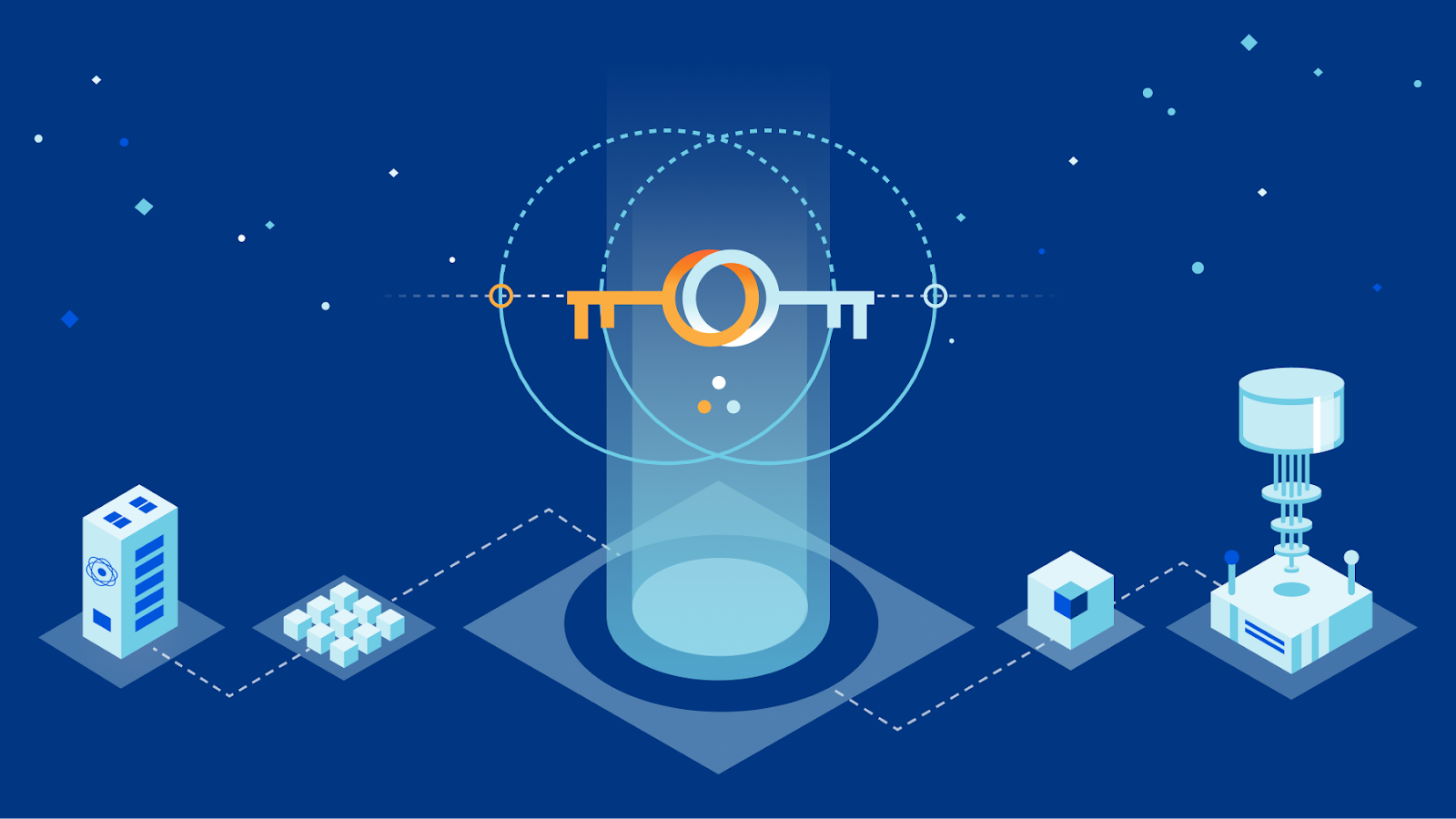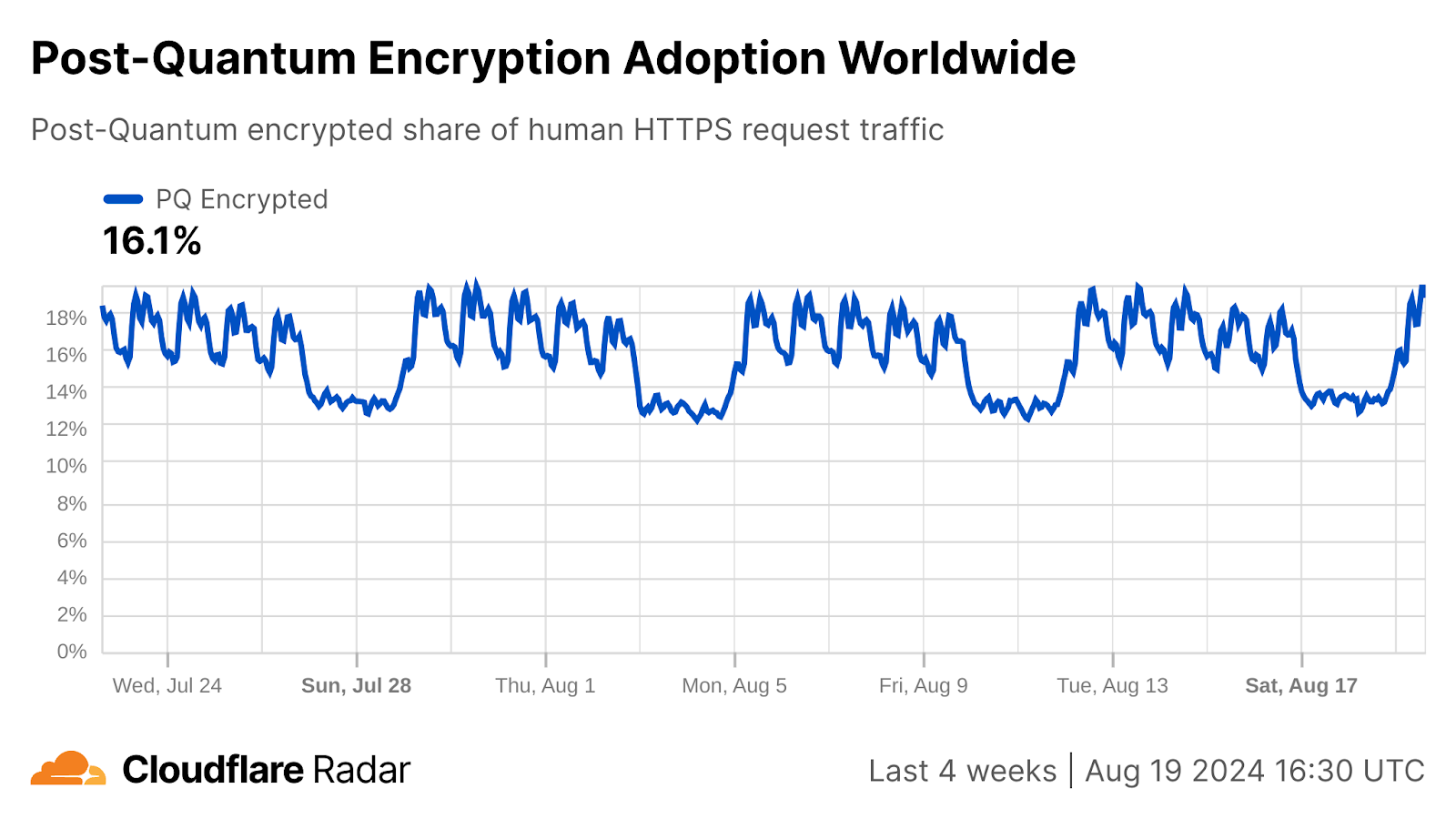2024-08-20
6 min read

On August 13th, 2024, the US National Institute of Standards and Technology (NIST) published the first three cryptographic standards designed to resist an attack from quantum computers: ML-KEM, ML-DSA, and SLH-DSA. This announcement marks a significant milestone for ensuring that today’s communications remain secure in a future world where large-scale quantum computers are a reality.
In this blog post, we briefly discuss the significance of NIST’s recent announcement, how we expect the ecosystem to evolve given these new standards, and the next steps we are taking. For a deeper dive, see our March 2024 blog post.
Why are quantum computers a threat?
Cryptography is a fundamental aspect of modern technology, securing everything from online communications to financial transactions. For instance, when visiting this blog, your web browser used cryptography to establish a secure communication channel to Cloudflare’s server to ensure that you’re really talking to Cloudflare (and not an impersonator), and that the conversation remains private from eavesdroppers.
Much of the cryptography in widespread use today is based on mathematical puzzles (like factoring very large numbers) which are computationally out of reach for classical (non-quantum) computers. We could likely continue to use traditional cryptography for decades to come if not for the advent of quantum computers, devices that use properties of quantum mechanics to perform certain specialized calculations much more efficiently than traditional computers. Unfortunately, those specialized calculations include solving the mathematical puzzles upon which most widely deployed cryptography depends.
As of today, no quantum computers exist that are large and stable enough to break today’s cryptography, but experts predict that it’s only a matter of time until such a cryptographically-relevant quantum computer (CRQC) exists. For instance, more than a quarter of interviewed experts in a 2023 survey expect that a CRQC is more likely than not to appear in the next decade.
What is being done about the quantum threat?
In recognition of the quantum threat, the US National Institute of Standards and Technology (NIST) launched a public competition in 2016 to solicit, evaluate, and standardize new “post-quantum” cryptographic schemes that are designed to be resistant to attacks from quantum computers. On August 13, 2024, NIST published the final standards for the first three post-quantum algorithms to come out of the competition: ML-KEM for key agreement, and ML-DSA and SLH-DSA for digital signatures. A fourth standard based on FALCON is planned for release in late 2024 and will be dubbed FN-DSA, short for FFT (fast-Fourier transform) over NTRU-Lattice-Based Digital Signature Algorithm.
The publication of the final standards marks a significant milestone in an eight-year global community effort managed by NIST to prepare for the arrival of quantum computers. Teams of cryptographers from around the world jointly submitted 82 algorithms to the first round of the competition in 2017. After years of evaluation and cryptanalysis from the global cryptography community, NIST winnowed the algorithms under consideration down through several rounds until they decided upon the first four algorithms to standardize, which they announced in 2022.
This has been a monumental effort, and we would like to extend our gratitude to NIST and all the cryptographers and engineers across academia and industry that participated.
Security was a primary concern in the selection process, but algorithms also need to be performant enough to be deployed in real-world systems. Cloudflare’s involvement in the NIST competition began in 2019 when we performed experiments with industry partners to evaluate how algorithms under consideration performed when deployed on the open Internet. Gaining practical experience with the new algorithms was a crucial part of the evaluation process, and helped to identify and remove obstacles for deploying the final standards.
Having standardized algorithms is a significant step, but migrating systems to use these new algorithms is going to require a multi-year effort. To understand the effort involved, let’s look at two classes of traditional cryptography that are susceptible to quantum attacks: key agreement and digital signatures.
Key agreement allows two parties that have never communicated before to establish a shared secret over an insecure communication channel (like the Internet). The parties can then use this shared secret to encrypt future communications between them. An adversary may be able to observe the encrypted communication going over the network, but without access to the shared secret they cannot decrypt and “see inside” the encrypted packets.
However, in what is known as the "harvest now, decrypt later" threat model, an adversary can store encrypted data until some point in the future when they gain access to a sufficiently large quantum computer, and then can decrypt at their leisure. Thus, today’s communication is already at risk from a future quantum adversary, and it is urgent that we upgrade systems to use post-quantum key agreement as soon as possible.
In 2022, soon after NIST announced the first set of algorithms to be standardized, Cloudflare worked with industry partners to deploy a preliminary version of ML-KEM to protect traffic arriving at Cloudflare’s servers (and our internal systems), both to pave the way for adoption of the final standard and to start protecting traffic as soon as possible. As of mid-August 2024, over 16% of human-generated requests to Cloudflare’s servers are already protected with post-quantum key agreement.

Other players in the tech industry have deployed post-quantum key agreement as well, including Google, Apple, Meta, and Signal.
Signatures are crucial to ensure that you’re communicating with who you think you are communicating. In the web public key infrastructure (WebPKI), signatures are used in certificates to prove that a website operator is the rightful owner of a domain. The threat model for signatures is different than for key agreement. An adversary capable of forging a digital signature could carry out an active attack to impersonate a web server to a client, but today’s communication is not yet at risk.
While the migration to post-quantum signatures is less urgent than the migration for key agreement (since traffic is only at risk once CRQCs exist), it is much more challenging. Consider, for instance, the number of parties involved. In key agreement, only two parties need to support a new key agreement protocol: the client and the server. In the WebPKI, there are many more parties involved, from library developers, to browsers, to server operators, to certificate authorities, to hardware manufacturers. Furthermore, post-quantum signatures are much larger than we’re used to from traditional signatures. For more details on the tradeoffs between the different signature algorithms, deployment challenges, and out-of-the-box solutions see our previous blog post.
Reaching consensus on the right approach for migrating to post-quantum signatures is going to require extensive effort and coordination among stakeholders. However, that work is already well underway. For instance, in 2021 we ran large scale experiments to understand the feasibility of post-quantum signatures in the WebPKI, and we have more studies planned.
What’s next?
Now that NIST has published the first set of standards for post-quantum cryptography, what comes next?
In 2022, Cloudflare deployed a preliminary version of the ML-KEM key agreement algorithm, Kyber, which is now used to protect double-digit percentages of requests to Cloudflare’s network. We use a hybrid with X25519, to hedge against future advances in cryptanalysis and implementation vulnerabilities. In coordination with industry partners at the NIST NCCoE and IETF, we will upgrade our systems to support the final ML-KEM standard, again using a hybrid. We will slowly phase out support for the pre-standard version X25519Kyber768 after clients have moved to the ML-KEM-768 hybrid, and will quickly phase out X25519Kyber512, which hasn’t seen real-world usage.
Now that the final standards are available, we expect to see widespread adoption of ML-KEM industry-wide as support is added in software and hardware, and post-quantum becomes the new default for key agreement. Organizations should look into upgrading their systems to use post-quantum key agreement as soon as possible to protect their data from future quantum-capable adversaries. Check if your browser already supports post-quantum key agreement by visiting pq.cloudflareresearch.com, and if you’re a Cloudflare customer, see how you can enable post-quantum key agreement support to your origin today.
Adoption of the newly-standardized post-quantum signatures ML-DSA and SLH-DSA will take longer as stakeholders work to reach consensus on the migration path. We expect the first post-quantum certificates to be available in 2026, but not to be enabled by default. Organizations should prepare for a future flip-the-switch migration to post-quantum signatures, but there is no need to flip the switch just yet.
We’ll continue to provide updates in this blog and at pq.cloudflareresearch.com. Don’t hesitate to reach out to us at [email protected] with any questions.
Cloudflare's connectivity cloud protects entire corporate networks, helps customers build Internet-scale applications efficiently, accelerates any website or Internet application, wards off DDoS attacks, keeps hackers at bay, and can help you on your journey to Zero Trust.
Visit 1.1.1.1 from any device to get started with our free app that makes your Internet faster and safer.
To learn more about our mission to help build a better Internet, start here. If you're looking for a new career direction, check out our open positions.
